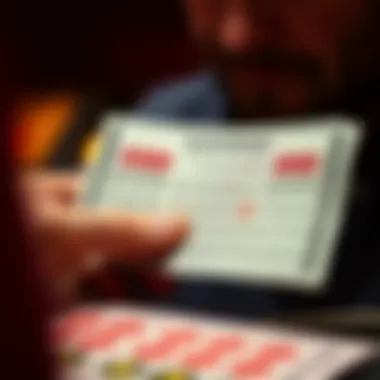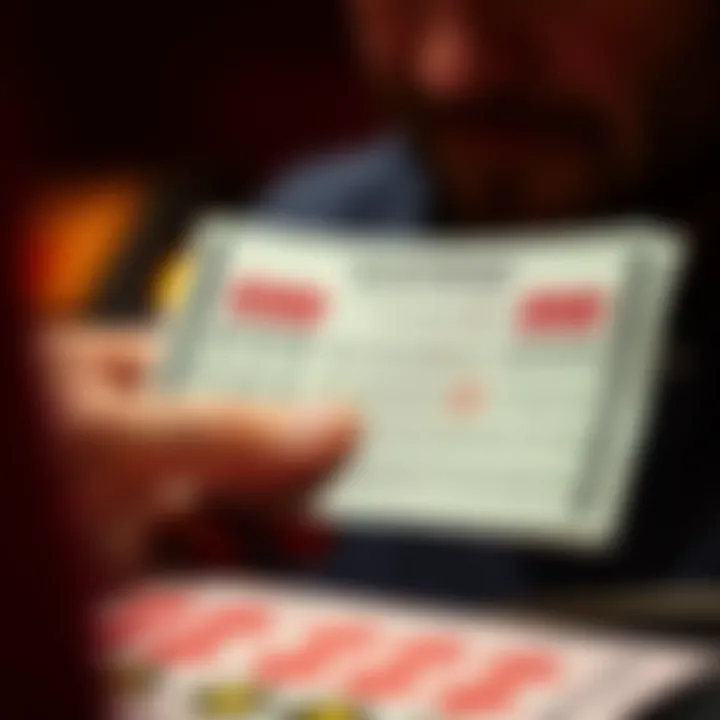A Comprehensive Guide to Kentucky Lottery Scratchers


Intro
The world of Kentucky Lottery scratchers is a fascinating junction of chance, strategy, and local culture. For many residents, running down to the gas station to grab a ticket isn’t just about the possibility of a cash windfall; it’s part of the routine. Scratch-offs present a unique allure. They are more than mere games of luck; they are snippets of excitement wrapped in colorful packaging. The thrill of scratching away the coating to reveal hidden numbers or symbols engages players in a manner that's both simple yet electrifying.
In the state of Kentucky, these scratchers have crafted a niche of their own. Introduced to generate revenue for various community programs, as well as to entertain, they have evolved remarkably since their inception. Let’s peel back the layers to uncover why these tiny pieces of paper hold such magnetic appeal, what it takes to play them wisely, and how they affect our local economy.
There's music to the rhythm of scratching a ticket at the table or in the waiting room. It’s not just an isolated event but a shared experience that transcends age, background, and even social standing. That shared anticipation drips from the fingertips of players who indulge, waiting to see if today could be their lucky day. With that in mind, we’ll dive into what makes Kentucky Lottery scratchers tick, exploring the variety available, the game mechanics, the odds of winning, and the broader implications on both a personal and community level.
Preface to Kentucky Lottery Scratchers
The world of Kentucky Lottery scratchers is an intriguing one, blending the thrill of instant gratification with the hope of hitting the jackpot. In a state known for its rich history and diverse landscape, scratch-off tickets have carved out their niche, becoming a staple in the gambling culture. With a vibrant array of options available, both casual players and seasoned gamblers find themselves drawn to the colorful and often flashy tickets that promise quick wins.
Understanding scratchers is not just about knowing how to play; it's about grasping their significance in the broader context of the gambling landscape. From their inception to the various themes, payouts, and game mechanics, each aspect reveals a layer of engagement that can enhance the player experience. The appeal of scratch-off games often lies in their accessibility. Unlike more elaborate gambling formats that require learning complex rules or game strategies, scratchers offer a straightforward approach. A player simply purchases a ticket, scratches it, and reveals the outcome, which can lead to excitement or disappointment within mere seconds.
Scratchers have become central to discussions on responsible gaming, particularly with concerns surrounding addiction. They hold an undeniable allure that can sometimes overshadow the importance of moderation. It's crucial for players to remain informed about both the potential risks and the enjoyment that comes from engaging in this activity sensibly.
In this article, we will break down the various elements of Kentucky Lottery scratchers, examining their history, types, mechanics, and impact on the local economy. With this comprehensive guide, readers will not only understand how these games function but also be equipped with insights that will enable them to navigate this colorful gamble wisely.
Overview of Scratch-off Games
Scratch-off games, or scratchers, have gained immense popularity due to their innovative simplicity and instant rewards. Introduced more than a few decades back, they evolved from mere paper tickets into a multi-billion-dollar industry. Players from all walks of life are drawn to these games, whether at the corner convenience store or online, taking a shot at winning big dollars with a few quick swoops of a coin.
Typically, scratch-off tickets feature engaging themes that resonate with various demographics. Some may appeal to die-hard sports fans, while others resonate with the artsy crowd or those eager for a dose of adventure. The design and plot points combine to create an experience that’s more than just a game; it's almost a story being told with each scratch.
Relevance in the Gambling Landscape
In the broader realm of gambling, scratchers hold a significant position. Their distinct nature sets them apart from traditional lotteries, casinos, and poker. Scratch-off games cater to a demographic that craves immediacy—the kind of players who don’t want to wait days for a lottery draw or sit for hours at a poker table. This accessibility makes them particularly appealing to new gamblers, allowing them to dip their toes into the water without being overwhelmed.
Many states, including Kentucky, have harnessed the revenue generated from scratchers to fund important community projects, which in turn can enhance their appeal to players. When a scratch-off ticket not only gives a chance to win money but also contributes to local education or infrastructure, it adds an extra layer of significance
"Scratchers are not just a chance to win—they're a chance to contribute to the community."
As Kentucky continues to explore new ways to engage players, the role of scratch-off games remains pivotal in both economic and social contexts, reminding players not just of the money at stake, but also of the larger picture they are a part of. This intricate web of personal gain and community contribution ensures that Kentucky Lottery scratchers remain relevant in today’s gambling landscape.
History of Kentucky Lottery
The history of the Kentucky Lottery is a telling saga of change, hope, and a touch of luck for the Commonwealth and its residents. Since its inception, the lottery has played a significant role in shaping the state's economic landscape and providing essential funding for public services. Understanding this history is crucial not just for avid gamblers but also for anyone interested in the interplay between state governance and citizen engagement in games of chance. This journey through time reveals how Kentucky has embraced the lottery, particularly scratch-off games, offering a blend of entertainment and financing for education and infrastructure projects.
Establishment and Evolution
The Kentucky Lottery was officially established in 1988, following a statewide referendum that saw a significant majority of citizens voting in favor of legalizing a state-operated lottery. The reasoning behind this was two-fold: it would generate much-needed revenue while also providing a means for residents to engage in gaming activities without the undercurrents of illegal gambling.
In its initial years, the lottery mainly offered traditional draw games, which included Powerball and Lucky for Life, but it wasn't long before scratch-off tickets began to capture the attention of players. The first scratch-off tickets were introduced in 1989, marking a pivotal moment that would set the stage for future growth. These instant-win games required little investment and were easy to play, appealing to a diverse audience, whether they were seasoned gamblers or curious newcomers. The introduction of larger ticket prices and higher payout prizes further enhanced the attraction, fueling sales and game participation.
As the years rolled by, the Kentucky Lottery expanded its offerings, integrating various themes and promotional campaigns that tapped into local culture and events. Availability of tickets shifted from just physical retailers to the digital space, allowing players to purchase their scratchers online. The seamless transition to digital gameplay underscored a significant evolution in the lottery's approach to reach customers, particularly younger demographics who prefer online transactions.
Fast-forwarding to today, the Kentucky Lottery now boasts a plethora of scratch-off games, categorized by price and prize potential, each designed with unique themes ranging from local iconography to seasonal events. This variety is essential in maintaining player engagement and continually drawing in new participants excited by the prospect of winning.
Milestones in Scratch-off Game Development
The development of scratch-off games in Kentucky is dotted with notable milestones that reflect both the creativity behind game design and the changing trends in consumer preferences. Initially launched to complement draw games, scratchers quickly evolved into a core product for the lottery.
- 1999: The Kentucky Lottery introduced the first $20 scratch-off ticket, which opened the door for high-stakes instant games. This marked a turning point for players who were willing to spend more for the chance at larger prizes.
- 2000s: The 2000s witnessed the introduction of themed games like “Kentucky Derby,” linking local culture with lottery products. These games captured the state’s attention and contributed to the cultural fabric of the lottery itself.
- 2010: The launch of the Kentucky Lottery mobile app allowed players to buy scratchers and check results from their smartphones, a significant leap forward in accessibility and convenience.
- 2018: The introduction of interactive and social components to scratch-off games, leveraging digital engagement, allowed players to connect in new ways, enhancing the communal aspects of winning and gaming.
These milestones not only illustrate the evolution of the scratch-off games but also highlight how the Kentucky Lottery has adeptly navigated changing technologies and population preferences. This adaptability helps ensure the lottery remains relevant and economically beneficial for the state.
"The evolution of the Kentucky Lottery mirrors the journey of its people—a blend of tradition, adaptability, and a dash of luck."
In summary, the history of the Kentucky Lottery, especially its scratch-off games, is not just about the pursuit of luck, but also about the community and financial support it provides. Understanding this historical context enriches the experience for players, allowing them to feel a connection to a tradition that extends beyond mere chance.
Types of Scratchers Available
Understanding the different types of scratch-off tickets available in the Kentucky Lottery is crucial for players looking to maximize their entertainment and potential returns. These tickets come in various forms, each catering to different tastes and budgets. The diversity of these games enhances their appeal, as players can choose options that align with their preferences and financial capabilities. The examination of scratcher types also provides insight into how the Kentucky Lottery aims to engage a broad audience, ensuring that there’s something for everyone, from casual gamers to serious players.


Categorization by Price Points
When it comes to Kentucky Lottery scratchers, one of the first things players notice is the price points. These scratch-off games can usually be found in a range of prices, often starting from as low as one dollar and climbing up to twenty dollars or more. The price of a ticket generally correlates with the potential prize—higher-priced scratchers typically offer larger jackpots and more lucrative odds.
For instance, a five-dollar scratcher might offer a modest grand prize, while a ten-dollar ticket could provide a life-changing sum for the lucky player. However, it's not just about the prize money; ticket prices can also influence decision-making. Players often weigh their budget against the expected value and the enjoyment of scratching off the ticket. Here are a few categories to consider:
- Low-Priced Scratchers: Usually between one and three dollars. These are great for casual players looking to test their luck without breaking the bank.
- Mid-Range Scratchers: Falling between four and ten dollars, these tend to strike a balance between prize scale and affordability.
- High-Ticket Scratchers: Ten dollars and above. Designed for those who are more committed and willing to invest in their chances at winning big prizes.
Themed and Seasonal Scratchers
Themed scratchers have become a significant marketing strategy for the Kentucky Lottery. These games often reflect popular culture, holidays, or local interests, which makes them appealing to a diverse audience. For example, you might find winter wonderland themed tickets around the holidays or sporting event scratchers tied to local teams.
Such thematic elements create an enjoyable scratching experience, resonating with players' emotions and current interests. The special graphics and unique gameplay often provide added excitement, encouraging people to try their luck. Seasonal scratchers, specifically, hold a particular charm and can become collectible items for avid fans. They push the ticket boundaries beyond just being a chance to win money, integrating the thrill of the season into the game itself.
Here are some specifics:
- Holidays: Games designed specifically for Christmas, Halloween, or Independence Day, often featuring festive symbols and colors.
- Local Culture: Scratchers may celebrate the state’s rich history or notable events, keeping the ties to Kentucky strong.
- Event-Specific: Tickets created in connection with major sporting events, festivals, or community activities to bolster engagement.
Lifecycle of Scratch-off Games
The lifecycle of scratch-off games is another fundamental aspect that players should understand. Each scratcher enters the market with a set timeframe and operates through phases that affect its availability and appeal.
- Launch: New scratchers often generate buzz when they��’re rolled out, featuring a marketing push to entice players to try them.
- Peak Interest: This phase follows closely when people scratch their fingers to find out what the new ticket holds. Higher sales typically occur here as it captures the fascination of players eager for fresh experiences.
- Decline: Over time, interest may wane as each winning opportunity diminishes. Players can often sense when a game is nearing the end of its lifecycle, leading to a decline in purchases.
- Retirement: Finally, once sales fall too low, the game is retired, making way for new ones. This cycle ensures that the Kentucky Lottery remains fresh and engaging, providing players a variety of options.
As seen through various timelines of successful games, players are always on the lookout for the latest and greatest. Having a grasp on the lifecycle helps players strategize their purchases effectively, ensuring they’re hitting games while interest is high yet keeping an eye on their budget.
In summary, the types of scratchers available in Kentucky offer a unique blend of experience, engagement, and financial potential. By understanding the categorization by price points, the charm of themed and seasonal scratchers, and the lifecycle of these games, players can make informed decisions that enhance their gaming experience.
How Scratchers Work
Understanding how scratchers work is pivotal in grasping the appeal of the Kentucky Lottery. These games, often perceived as simple forms of entertainment, actually embody a complex interplay of mechanics, psychology, and economic factors. The sheer variety, from instant gratification to intricate design, caters to myriad player preferences, making scratch-off tickets a consistently popular gamble. By exploring the core elements of game mechanics and the intricacies of odds and payouts, potential players can navigate the landscape more effectively.
Game Mechanics and Rules
Game mechanics serve as the heartbeat of scratch-off tickets. At first glance, scratching off a ticket might seem trivial. However, behind that apparent simplicity lies a well-structured system. Scratchers generally consist of symbols, numbers, or images concealed under a coating that players scratch away to reveal results. Familiarity with the rules is essential for any serious player. For instance:
- Tickets often range from $1 to $30, each with varying prizes and odds of winning.
- Each ticket lists instructions that may include combinations to match or amounts needed to claim a prize.
- Prizes can be fixed amounts or could offer a progressive jackpot, depending on the type of game.
Taking a moment to understand these game rules increases the chances of maximizing enjoyment and potentially securing a win. Additionally, many scratchers introduce special features like "bonus" spots, where players scratch off additional sections for extra rewards, increasing engagement and excitement.
Understanding Odds and Payouts
Another critical aspect regarding scratch-off tickets is the understanding of odds and payouts. While the thrill of scratching a ticket can be intoxicating, discerning the likelihood of winning is essential for responsible play. Here are some key points:
- Odds of Winning: Each game has a predefined set of odds, usually printed on the back of the ticket. This indicates how likely a player is to win any prize or a designated top prize.
- Payout Percentage: Lottery organizations commonly provide information on the payout percentage, showing the proportion of revenue that returns to players. For instance, a game might have a payout of 60%, meaning 60% of all ticket sales goes back to players in winnings.
- Expected Value: Players should familiarize themselves with the expected value of a ticket, which is calculated by considering the potential rewards versus ticket cost. A $5 scratch ticket with a 1 in 10 winning ratio can give you a tangible sense of what you can expect in return.
"Knowing the odds not only helps in making informed decisions but also ensures that the fun of playing does not edge into unwise risk-taking."
Arming oneself with this knowledge transforms the perception of scratchers from mere chance to a strategic engagement. Thus, players can play smarter and perhaps more responsibly, shedding light on their own gambling habits.
Buying and Claiming Scratchers
Acquiring Kentucky Lottery scratchers isn't just a matter of purchasing a ticket; it involves an understanding of where to buy, the options available, and how to maximize the experience of playing these games. This section dives into the nitty-gritty of buying and claiming scratch-off tickets, emphasizing why these aspects are fundamental to the overall lottery experience.
Retail Outlets and Online Purchases
Finding scratchers in Kentucky is quite straightforward, thanks to numerous retail outlets scattered across the state. Gas stations, convenience stores, and supermarkets frequently sell scratch-off tickets. Shoppers may notice brightly colored displays, often near the checkout counters, drawing attention to the various games on offer. Notably, these tickets vary in price and theme, encouraging players to try their luck with something new.
For those who prefer the comfort of their home, online platforms provide easy access to Kentucky Lottery products. With a few clicks, individuals can browse available games, examine their odds, and make purchases right from their smartphones or computers. This convenience has become particularly appealing, especially during times when being out and about isn't feasible for everyone. However, it’s crucial to ensure any online site is legitimate, adhering to state regulations.
"Buying scratchers online can feel like a stroll down the digital mall, where the choices are vast and the potential wins linger just a click away."
Claiming Prizes: Procedures and Tips
Claiming a prize from a scratch-off game can add a sprinkle of excitement to the gaming experience. The process isn't overly complicated, but understanding the proper procedures can save players from unnecessary headaches later.


- Immediate Check: After scratching off the ticket, verify the winnings right away. Most players prefer using a lottery ticket scanner found in retailers or the official app from the Kentucky Lottery for confirmation.
- Small Wins: For prizes under $600, winners can simply claim their money at any authorized retailer. This approach is quick and efficient, allowing players to pocket their winnings without much delay.
- Larger Prizes: If the scratcher yields a win of $600 or more, claimants must visit a Kentucky Lottery office. It’s here where they’ll need to fill out a claim form and provide valid identification. Players are often advised to bring the ticket, ID, and a printed claim form from the Kentucky Lottery’s website.
- Time Limits: Keep in mind that tickets must be claimed within a specific timeframe, typically within 180 days of the game’s conclusion. Marking this on a calendar can help avoid missing out on potential wins.
Additionally, remember to take precautions when it comes to winnings:
- Stay anonymous if possible, especially for larger wins, by signing the back of the ticket immediately upon winning.
- Seek financial advice, particularly when claiming life-altering sums. The process can be overwhelming, and advice can help in making sound choices regarding taxes and spending.
In summary, knowing how and where to buy scratchers, along with understanding the claiming process, can enrich a player's overall experience. By navigating these facets mindfully, players not only amplify their enjoyment but also ensure that they make the most of their participation in Kentucky's lottery system.
Economic Impact of Kentucky Lottery
The economic implications of the Kentucky Lottery go beyond mere financial figures; they resonate within communities and influence various sectors, including education and public service funding. To understand the significance of the Kentucky Lottery, one must comprehend not only how it generates revenue but also the broader effects it has on society. With scratch-off lottery tickets becoming a staple in the gambling landscape, their economic impact merits a closer examination.
Revenue Generation for the State
The Kentucky Lottery serves as a robust revenue stream for the state, generating funds that are vital for various programs. Each month, millions of dollars are collected through ticket sales, with scratchers being a major contributor. The allure of instant gratification often draws many toward these games, pushing sales to new heights. Essentially, these scratchers are not only appealing to the thrill-seekers but also act as a financial lifeline for the state.
Consider this: in 2022, the Kentucky Lottery reported over $1 billion in total sales, a significant portion of which was derived from scratch-off tickets. This influx of funds is life-blood for state initiatives, funding projects that otherwise might struggle for financial support.
"The Kentucky Lottery is a testament to how entertainment can translate into essential funding for the state’s needs."
By analyzing these trends, state planners and economists can glean insights into consumer behavior and adjust their strategies accordingly. As more players try their luck on scratch-offs, the potential for revenue continues to grow, providing an opportunity for the state to tweak allocations in critical sectors.
Funding for Education and Public Services
Moreover, the revenue generated from scratch-off games significantly supports education and public services across Kentucky. A substantial percentage of the lottery’s revenue is earmarked for educational programs, bolstering everything from K-12 education to higher learning initiatives.
- Approximately 60% of the net proceeds are directed towards the Kentucky Educational Excellence Scholarship (KEES), helping students afford college education.
- In the fiscal year of 2021, over $250 million was channeled into public schools, local government services, and social programs, showcasing just how integral the lottery has become in funding public needs.
The impact stretches beyond just immediate funding; it fosters a system where local governments can allocate more to community projects, infrastructure, and post-secondary education programs, enhancing the overall quality of life. As communities benefit from this funding, the cycle continues, encouraging more participation in lottery plays, with the revenue ultimately reinvesting in the community.
In summary, the Kentucky Lottery exemplifies how a seemingly simple game can transform lives and impact societal structures. With its continued growth and financial promise, especially through scratch-off games, the prospects for educational funding and vital public services remain bright in the Bluegrass State.
Responsible Gambling Practices
Responsible gambling practices play a crucial role in the Kentucky Lottery ecosystem. They ensure that the thrill of scratch-off games doesn't morph into harmful behaviors. Understanding these practices isn't just about following rules; it's about recognizing the fine line between entertainment and addiction. The Kentucky Lottery emphasizes safety, awareness, and education in its approach to gambling.
In this section, we will explore the importance of these practices, examining the tools and strategies available to players. The main goal is to promote a healthy relationship with gambling activities. By embracing responsible gambling, players can enjoy the excitement of scratchers while minimizing risks.
Understanding Gambling Addiction
Gambling addiction is a serious issue that can lead to devastating consequences. It is often described as a compulsion to continually gamble despite harmful outcomes. Many individuals start playing scratchers as a casual pastime without realizing the potential for addiction lurking in the shadows.
Some key points to consider in understanding gambling addiction include:
- Triggers: Many players gamble to escape stress or seek thrill. Recognizing personal triggers can help in making informed choices.
- Behavior Patterns: If gambling becomes a priority over relationships or responsibilities, it might signify a deeper problem.
- Financial Consequences: Some individuals may drain their savings or accumulate debt due to their gambling habits, impacting not just them but their families as well.
" Gambling is like a double-edged sword; it can bring joy but may also cut deep into one’s life if not handled with care."
Awareness of these facets promotes a proactive mindset toward preventing addiction from taking hold. Sharing stories and experiences fosters a sense of community amongst players and helps hold each other accountable.
Resources for Problem Gamblers
The Kentucky Lottery recognizes the need for support services aimed at problem gamblers. There are several resources and programs available that offer help to those in need:
- 24/7 Helplines: Organizations like the Kentucky Council on Problem Gambling offer immediate assistance through confidential hotlines. Players can call at any hour if they feel overwhelmed.
- Counseling Services: Professional counseling is often effective for treating gambling addictions. Counselors trained in the area can provide tailored strategies and support.
- Support Groups: Many communities host peer support groups where individuals can share their experiences and strategies for recovery.
- Self-Exclusion Programs: The Kentucky Lottery provides options for self-exclusion, allowing players to voluntarily exclude themselves from participating in lottery games for a specified period.
Finding help with gambling addiction is not a sign of weakness; it displays strength and the desire to reclaim control. By accessing available resources and openly discussing issues surrounding gambling, individuals pave the way toward healthier play.
For further reading or resources, check out:
Statistical Analysis of Game Outcomes


Understanding the statistical analysis of game outcomes is crucial for anyone engaging with Kentucky Lottery scratchers. This section sheds light on the importance of discerning the underlying probabilities and outcomes, and how they influence players' experiences and decisions.
Effective use of statistical analysis empowers players by enabling them to make informed choices about which games to play. It lays the foundation for predicting potential winnings based on the established odds, allowing for strategic decision-making rather than mere chance.
Players can avoid the trap of chasing losses or spending recklessly when they understand the statistical framework behind scratchers. Moreover, it adds an element of strategy and intellect to a game often driven by luck, elevating engagement and maximizing enjoyment.
Probability and Expected Value
Probability forms the backbone of any lottery game, including scratchers. When players purchase a scratch-off ticket, they are effectively making a wager on the likelihood of exposing a winning combination. Each ticket has a set probability of winning based on its total number of tickets printed and the number of winning tickets available.
The expected value (EV) is a key concept that every player ought to grasp. It is calculated by multiplying the probability of each outcome by the payout of that outcome and then summing these values. In simpler terms, the EV provides a sense of what a player can expect to win—or lose—over the long haul.
For example, if a scratcher ticket costs $5 and has a payout of 50 cents on a win 1 out of every 10 times, the expected value can be calculated as follows:
EV = (Probability of Winning * Winning Amount) - (Probability of Losing * Losing Amount)
Understanding these figures helps players select games that offer the best odds and payout potential, giving them an edge before even scratching the first ticket.
Analyzing Winning Patterns
Many players find themselves captivated by the notion of patterns. In the realm of lottery scratchers, analyzing winning patterns can provide insight into trends that may seem to defy chance. It's not just about scratching and praying; it's about observing and learning.
While each scratch-off game is designed to be random, players can gather information about which types of tickets yield more winners. For instance, a player might notice that certain themed scratchers tend to produce more wins compared to others. This type of analysis often leads to hypotheses about gameplay strategies that might improve fortunes.
Furthermore, players can keep a record of their scratcher encounters, noting their wins and losses across different games, price points, and even store locations. As they filter through this data, patterns may emerge—certain games or stores may show a higher frequency of payouts. This approach shifts the focus from playing purely based on luck to integrating strategy and data collection into the decision-making process.
In essence, statistical analysis and the hunt for winning patterns cultivate a more informed player base, transforming scratch-off games into a more engaging and calculated venture. Keep your wits about you, and who knows? You might just find that golden ticket amid the numbers.
Consumer Behavior and Scratchers
Understanding consumer behavior in the context of Kentucky Lottery scratchers is essential for grasping the broader implications of these games within the local gambling culture. The way players interact with scratch-off tickets is influenced by various factors including demographic backgrounds, psychological motivations, and social contexts. By examining these elements, we can delineate why individuals engage with these games and what drives their choices.
Demographics of Scratch-off Players
Demographic insights provide a clearer picture of who plays Kentucky Lottery scratchers. Commonly, this population includes a diverse range of ages and socioeconomic backgrounds. While it's tempting to think that younger players may dominate the scene, data indicates a more layered reality.
- Age Range: Players often span various age groups, from college students eager to try their luck to retirees seeking that thrill. Interestingly, middle-aged individuals, often settled in their careers, tend to spend significantly on scratch-offs. They appreciate the instant gratification these tickets offer amidst a busy life.
- Income Levels: Surprisingly, scratchers attract players from both lower and higher income brackets. Those with modest means may gravitate towards lower-priced tickets as a form of entertainment, while affluent players engage with premium tickets that boast larger jackpots. This creates a dynamic market where different pricing strategies cater to varied consumer profiles.
- Education: The educational background of players can influence their approach. Studies show that individuals with higher educational qualifications might analyze the odds involved more critically, yet may still succumb to the allure of a quick win. This juxtaposition emphasizes how knowledge does not necessarily equate to avoidance of gambling risks.
Psychological Factors Influencing Play
The psychology behind scratch-off ticket purchases is a fascinating aspect that sheds light on addictive behaviors and enjoyment derived from games of chance. Understanding these factors can aid not only stakeholders in formulating strategies but also players in making informed decisions.
- Instant Gratification: The joy of instant results cannot be overstated. Players are often drawn to the immediate feedback of scratchers, which contrasts sharply with the delayed rewards found in traditional lottery draws. This quick satisfaction becomes addictive for many, leading to repetitive play.
- Controlled Risk: Scratching off tickets provides an illusion of control. Players partake in a gamble, yet they can decide how much to stake and when to stop. This modicum of control can be comforting, often attracting those who shy away from riskier gambling options like poker or sports betting.
- Social Influence: The role of social circles further complicates consumer behavior. Friends or family members discussing their wins can create a ripple effect, encouraging others to join in on the fun. The community aspect surrounding scratchers fosters shared experiences, whether it’s winning or losing, further entrenching players in this world.
"The interplay of consumer trends emphasizes that scratch-off players are not merely seeking monetary gain but often find entertainment, social connection, and fleeting moments of hope."
Players' motivations may encapsulate a blend of risk, thrill-seeking behaviors, and even a sense of community. Understanding these deeper psychological factors also lays the groundwork for promoting responsible gambling practices, ensuring that engagement with these scratchers remains a positive pastime rather than a detrimental habit.
For further exploration into this topic, resources such as the Kentucky Lottery, as well as riding the waves of social discourse on platforms like Reddit, can provide nuanced insights into actual consumer sentiments.
Culmination
In wrapping up the discussion on Kentucky Lottery scratchers, it's crucial to highlight the various layers of significance that this topic holds. As an avenue of entertainment and a potential source of revenue for the state, scratch-off games serve multiple roles. Not only do they provide a thrill for players, but they also contribute significantly to community funding through education and public services.
Summary of Insights
The exploration of Kentucky Lottery scratchers reveals important insights into their mechanics, variety, and cultural relevance. From the inception of the lottery to the evolution of scratch-off games, each aspect underscores a blend of excitement and opportunity. Players are drawn to these games for their simplicity and potential for instant gratification. It's fascinating to note that the odds, while often daunting, don’t deter participation but rather enhance the thrill for many.
Moreover, demographic trends show a diverse player base, indicating that these games appeal across age and socioeconomic groups. Psychological factors also play a critical role; the colorful designs and enticing payouts create an environment where participants feel they might just strike it rich with a single scratch.
"Knowledge is power, especially in gambling. The more informed a player becomes, the better their chances of making wise decisions."
This sentiment rings true as those who understand the statistics and the odds are often better equipped to engage responsibly, enhancing their overall experience.
Future Trends in Kentucky Lottery Scratchers
Looking toward the future, several trends may shape the landscape of Kentucky scratchers. First, technology is likely to play a larger role in how these games are marketed and accessed. The rise of online platforms and mobile applications may open the door for innovative formats that could draw in younger players, who prefer digital interactions.
Furthermore, as players become more conscious of responsible gambling practices, there may be an increased demand for transparency in game mechanics. This could spur regulators and gaming operators to provide more detailed information regarding odds and payouts. Seasonal themes may also see a resurgence, appealing to nostalgia and regional identity, tapping into what makes Kentucky unique.
In sum, the landscape of Kentucky Lottery scratchers is ever-evolving, driven by both player interests and shifts in technology and regulation. As these trends unfold, they will not only play a role in shaping consumer behavior but will also impact the broader economic and social implications associated with the lottery system. Players, marketers, and policymakers must remain attuned to these dynamics to navigate the complexities of this vibrant part of Kentucky's gambling landscape.







